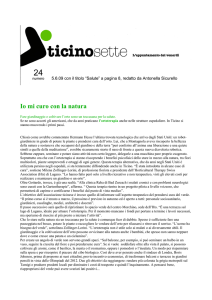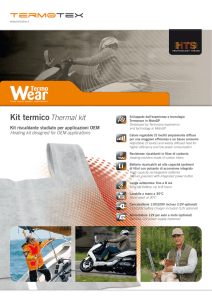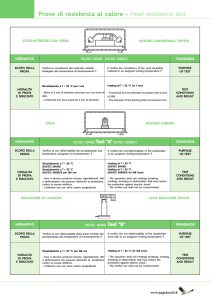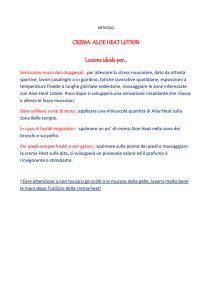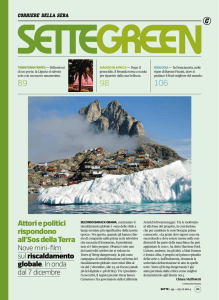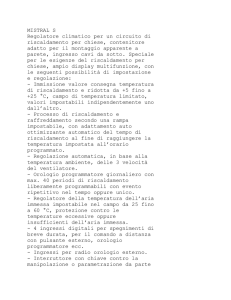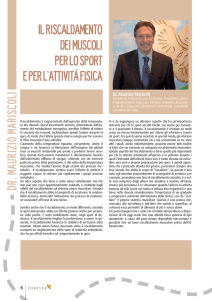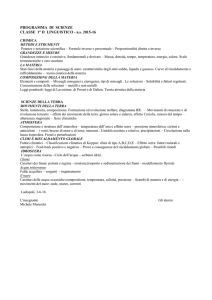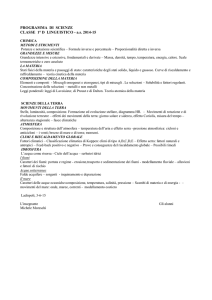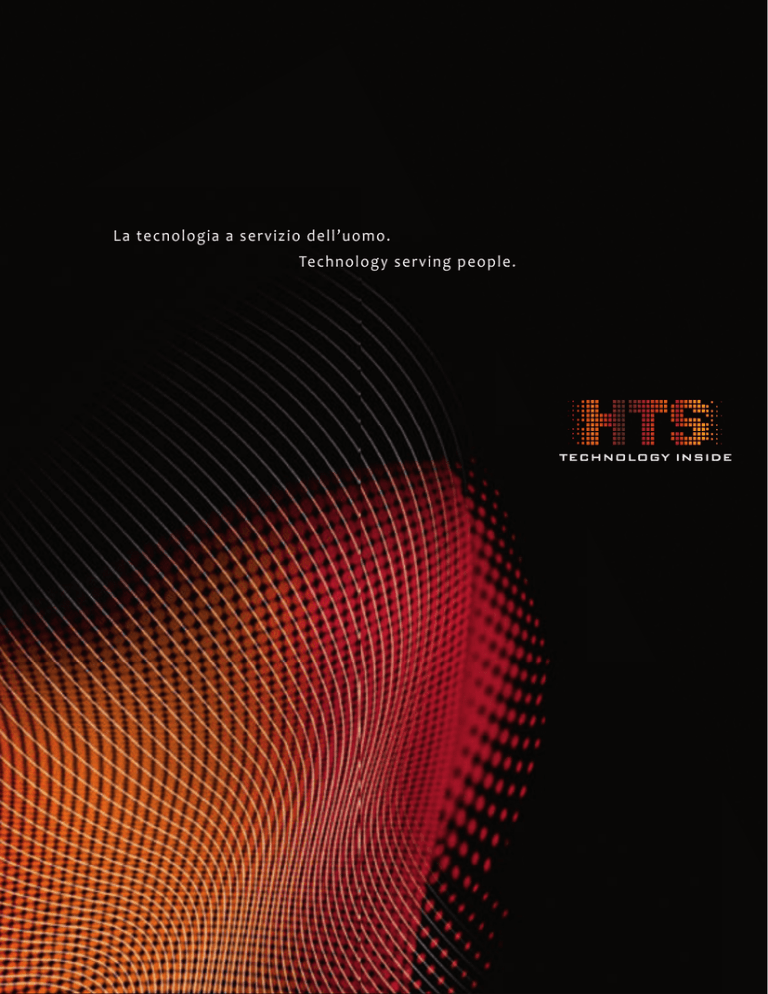
L a t e c nologia a servizio dell’uomo.
Technology serving people.
LA TECNOLOGIA HTS / HTS TECHNOLOGY
L ’ I N N O VA ZI O N E TECNOLO GICA FIRMATA HTS
Il progetto HTS nasce nel 1992 e si sviluppa fino al deposito di un brevetto internazionale e del relativo marchio.
La vera innovazione introdotta da HTS è l’utilizzo del carbonio che presenta due importanti proprietà:
- ha una conducibilità elettrica di valore intermedio tra quello delle fibre sintetiche e quello dei metalli. Pertanto il filo di
carbonio, se attraversato da corrente elettrica, è soggetto ad un effetto Joule molto elevato ed è quindi sufficiente una
corrente a basso voltaggio per sviluppare calore;
- il carbonio non sviluppa ossidi solidi, ma solamente ossidi gassosi ad altissime temperature perciò non subisce l’influenza
dell’umidità.
Questo comporta due vantaggi fondamentali: da un lato la bassa conducibilità permette di scaldare a bassa tensione garantendo
maggiore sicurezza agli utilizzatori (si evitano surriscaldamenti e folgorazioni); dall’altro è possibile realizzare prodotti portatili
alimentati con batterie da 6, 12 o 24 volt.
Tutto ciò può essere tradotto in termini di: EFFICIENZA, AFFIDABILITÀ, FLESSIBILITÀ, SICUREZZA.
HTS - Heating Textile Sanwich - è un semilavorato, costruito a sandwich, costituito da un tessuto riscaldante racchiuso tra due
strati tessili isolanti esterni.
Il cuore del HTS, il tessuto riscaldante, può essere realizzato mediante diverse tecnologie e ha la caratteristica di generare calore
quando gli viene applicata un’alimentazione elettrica.
HTS - Heating Textile Sandwich - is an intermediate product, with a sandwich construction, comprising a heating fabric enclosed
between two external insulating textile layers.
The core of the HTS, the heating fabric, can be made using different technologies and has the property of producing heat when
connected to an electrical supply.
ISOLANTE ESTERNO / EXTERNAL INSULATOR
H T S B R A N D ED T ECHNOLO GICAL INNOVATION
The HTS project was established in 1992 and culminated in the registration of a patent and associated trademark.
The real innovation introduced by HTS is the use of carbon, which has two important properties:
- Electrical conductivity of a value that is intermediate between that of synthetic fibres and metals. Consequently, when a carbon
fibre is subjected to a flow of electric current, it displays a very high Joule effect, which means that heat can be generated also in
the presence of very low electrical voltages ;
- Carbon does not give off solid oxides, only gaseous oxides at extremely high temperatures and so it is not affected by humidity.
This provides two fundamental advantages: on one hand the low conductivity makes it possible to heat at low voltage, ensuring
enhanced safety for users (avoiding overheating and electrical shocks); on the other hand it makes it possible to develop
portable products powered by 6, 12, or 24 volt batteries.
All this translates into: EFFICIENCY, RELIABILITY, FLEXIBILITY, and SAFETY.
TESSUTO RISCALDANTE HTS / HTS HEATING FABRIC
ISOLANTE ESTERNO / EXTERNAL INSULATOR
U na g a m m a d i p r o d o t t i c o m p l e t a / A c o m p l e t e r a nge o f p r o d u c t s :
HTW
HCE
HCW
HA M
HIP
Heating Thread Weaved
Heating Cord Embroidered
Heating Cord Weaved
Heating Aluminum Membrane
Heating Irradiating Panel
I PRODOTTI HTS / HTS PRODUCTS
HTW
I PRODOTTI HTS / HTS PRODUCTS
Heating Thread Weaved
Il tessuto HTW è un vero e proprio tessuto realizzato a telaio. È costituito da un ordito di filati non conduttivi al centro, mentre alle due
estremità sono presenti dei filati elettricamente conduttivi, generalmente in rame, che servono per alimentare il tessuto. La trama,
invece, è costituita da filati non conduttivi che si alternano a filati elettricamente conduttivi, generalmente in fibra di carbonio.
Variando la geometria del tessuto in termini di distanza, numero, sezione e lunghezza dei fili di carbonio, è possibile variare e calibrare
diverse potenze in funzione anche della tensione di alimentazione.
Il tessuto HTW può essere utilizzato anche in modo passivo, ovvero può essere connesso alla “terra” dell’impianto elettrico, per sfruttare
la sua elevata capacità schermante nei confronti dei campi elettromagnetici. Studi effettuati da laboratori specialistici accreditati ne
hanno dimostrato la reale efficacia.
HTW fabric is an actual woven fabric. It is made up from a warp of non conducting filaments in the centre, while at the two extremities
are electrically conducting fibres (usually copper), which serve to connect the electrical supply to the fabric. The weft consists of an
alternation of non-conductive filaments and electrically conductive filaments (usually carbon fibre). By varying the geometry of the
fabric in terms of distance, number, diameter, and length of the carbon filaments it is possible to vary and calibrate the power output,
also in relation to the input voltage.
HTW fabric can also be used in passive mode, connected to the earth of the electrical system in order to exploit its high shielding
capacity in relation to electromagnetic fields. Studies conducted by specialized accredited laboratories have proven its effectiveness for
this purpose.
CARATTERISTICHE TECNICHE:
•La forma geometrica deve essere rettangolare e limitata a superfici inferiori a 5 m2.
•Il range di temperatura tipico è di 30-40°C, ma può raggiungere anche i 250°C.
•La distribuzione del calore è perfettamente omogenea.
•Funziona a bassissima tensione (6÷48 V – AC/DC).
•Può raggiungere potenze fino a 300 W/m2.
•Può essere ricamato, forato o tagliato purché non vengano interrotte le bande di
alimentazione laterali.
•Può essere accoppiato ad altri materiali tessili e non.
•Può essere plastificato e reso totalmente impermeabile o traspirante a seconda delle
esigenze.
TECHNICAL CHARACTERISTICS:
• The shape must be rectangular and limited to surface areas of less than 5 m2.
HCE
H e a t i ng C o r d Em b r o i d e r e d
Il tessuto HCE è un pannello tessile su cui viene ricamato un filamento di carbonio isolato che può essere rivestito da una guaina isolante,
generalmente in silicone, teflon o PVC, termicamente conduttiva.
Variando la sezione del filamento e la sua distribuzione sul pannello, è possibile variare e calibrare le diverse potenze in funzione
anche della tensione di alimentazione. Si possono raggiungere temperature molto elevate fino ad un massimo di 250°C, ma il range di
temperatura medio è compreso tra 0-150°C.
HCE fabric is a textile panel on which an insulated carbon filament is stitched. The filament can be encased in an insulating sheath,
generally in thermally conductive silicone, Teflon, or PVC.
By varying the diameter of the filament and its distribution on the panel, it is possible to vary and calibrate the power output, also in
relation to the supply voltage. Very high temperatures can be obtained, up to a maximum of 250°C, but the average range of temperatures
is from 0 to 150°C.
CARATTERISTICHE TECNICHE:
•La forma geometrica può essere irregolare, adattata alle superfici da riscaldare e limitata
a superfici inferiori a 1,5 m2.
•La distribuzione del calore può anche essere disomogenea e variare a seconda della
zona da riscaldare.
•Funziona sia a bassissima tensione (6÷48 V – AC/DC) che a bassa tensione (110 V,
230 V, 380 V).
•Può raggiungere potenze fino a 3000 W/m2.
•Ha emissioni elettromagnetiche molto basse, ovviamente proporzionali alle potenze in
gioco e correlate alla forma geometrica.
•Può essere ricamato, forato o tagliato purché non venga interrotto il filamento di carbonio.
•Può essere accoppiato ad altri materiali tessili e non.
•Può essere plastificato e reso totalmente impermeabile o traspirante a seconda delle
esigenze.
• The typical temperature range is from 30 to 40°C, but can reach 250°C.
• The distribution of heat is perfectly uniform.
• Operates at extremely low voltages (6 to 48 V – AC/DC).
• Can delivery heating power levels of up to 300 W/m2.
• Can be embroidered, perforated, or cut as long as the lateral electrical connection bands
are not broken.
• Can be coupled with other woven and non-woven fabrics.
• Can be plasticized and made completely waterproof or breathable as required.
TECHNICAL CHARACTERISTICS:
VANTAGGI: La distribuzione omogenea del calore comporta temperature locali più basse che consentono una notevole riduzione dei
VANTAGGI: La possibilità di realizzare pannelli riscaldanti di qualsiasi forma e con una diffusione del calore anche non omogena, consente
ADVANTAGES: The uniform distribution of heat results in lower local temperatures, permitting considerable reductions in power consumption
ADVANTAGES: Heating panels can be made in any shape and with differentiated heat distribution, making them ideal for a broad range
consumi e quindi un rendimento molto elevato.
and consequently very high efficiency.
• The shape can be irregular, adapted to match the surface to be heated and limited to
surface areas of less than 1.5 m2.
• Heat distribution can be variable, with more or less heat supplied to specific areas.
• Operates both at very low voltages (6 to 48 V AC/DC) and low voltages (110 V, 230 V,
380 V).
• Can delivery power outputs of up to 3000 W/m2.
• Electromagnetic emissions are very low, proportional to the power levels involved and
correlated to the geometric shape.
• Can be embroidered, perforated, or cut as long as the carbon filament is not broken.
• Can be coupled with other woven and non-woven fabrics.
• Can be plasticized and made completely waterproof or breathable as required.
molteplici applicazioni.
of applications.
I PRODOTTI HTS / HTS PRODUCTS
HCW
Heating Cord Weaved
Il tessuto HCW è un vero e proprio tessuto realizzato a telaio. È costituito da un filamento di carbonio isolato inserito nella trama di un
tessuto. Variando la sezione del filamento e la sua distribuzione sul tessuto è possibile variare e calibrare le diverse potenze in funzione
anche della tensione di alimentazione.
HCW fabric is an actual woven fabric with an insulated carbon filament incorporated in the weft. By varying the diameter of the filament
and its distribution in the fabric it is possible to vary and calibrate the power output, also in relation to the supply voltage.
CARATTERISTICHE TECNICHE:
•La forma geometrica deve essere rettangolare.
•Le caratteristiche costruttive consentono di riscaldare superfici discretamente estese.
•Il range di temperatura tipico è di 30-40°C, ma può raggiungere anche i 90°C.
•Garantisce una distribuzione omogenea del calore.
•Funziona a bassa tensione (110 V, 230 V, 380V – AC/DC)
•Può raggiungere potenze fino a 150 W/m2.
•Ha emissioni elettromagnetiche nulle.
•Può essere ricamato, forato o tagliato purché non venga interrotto il filamento di carbonio.
•Può essere accoppiato ad altri materiali tessili e non.
•Può essere plastificato e reso totalmente impermeabile o traspirante a seconda delle
esigenze.
I PRODOTTI HTS / HTS PRODUCTS
HAM
H e a t i ng A l u m i nu m M e m b r a ne
La membrana HAM è un multistrato in alluminio laminato a sandwich con TNT resinato (poliestere, polietilene, …).
Variando lunghezza e larghezza della membrana e cambiando lo spessore del film di alluminio, è possibile variare e calibrare le diverse
potenze in funzione anche della tensione di alimentazione.
The HAM membrane is an aluminium multiply material laminated in sandwich construction with resin-bonded non-woven fabric
(polyester, polyethylene, etc.) . By varying the length and width of the membrane and the thickness of the aluminium film, it is possible
to vary and calibrate the heating power output, also in relation to the supply voltage.
CARATTERISTICHE TECNICHE:
•La forma geometrica deve essere rettangolare.
•Le caratteristiche tecniche consentono di riscaldare superfici molto estese.
•Il range di temperatura tipico è di 20-40°C.
•Garantisce una distribuzione del calore perfettamente omogenea.
•Funziona sia a bassissima tensione (7÷28 V – AC/DC) che bassa tensione (110 V, 230 V,
380 V).
•Può raggiungere potenze fino a 150 W/ m2.
•Ha emissioni elettromagnetiche nulle.
•La membrana può essere forata e parzialmente tagliata in quanto auto-cauterizzante.
TECHNICAL CHARACTERISTICS:
TECHNICAL CHARACTERISTICS:
• The shape must be rectangular.
• The construction characteristics make it possible to heat relatively large areas.
• The typical temperature range is from 30 to 40°C, but can reach 90°C.
• Guarantees uniform heat distribution.
• Operates at low voltages (110 V, 230 V, 380V – AC/DC)
• Can deliver power outputs of up to 150 W/m2.
• Complete absence of electromagnetic emissions.
• Can be embroidered, perforated, or cut as long as the carbon filament is not broken.
• Can be coupled with other woven and non-woven fabrics.
• Can be plasticized and made completely waterproof or breathable as required.
• The shape must be rectangular.
• The technical characteristics make it possible to heat very extensive areas.
• The typical temperature range is from 20 to 40°C.
• Guarantees perfectly uniform heat distribution.
• Operates both at very low voltages (7 to 28 V – AC/DC) and low voltages (110 V, 230 V,
380 V).
• Can deliver power outputs of up to 150 W/ m2.
• Complete absence of electromagnetic emissions.
• The membrane can be perforated and partially cut, since it is self-sealing.
VANTAGGI: La distribuzione omogenea del calore comporta temperature locali più basse dei sistemi di riscaldamento tradizionali.
VANTAGGI: La distribuzione omogenea del calore comporta temperature locali più basse dei sistemi di riscaldamento tradizionali.
ADVANTAGES: The uniform heat distribution results in lower local temperatures than in conventional heating systems.
ADVANTAGES: The uniform heat distribution results in lower local temperatures than in conventional heating systems.
Ciò implica una notevole riduzione dei consumi e quindi un rendimento molto elevato con emissioni elettromagnetiche nulle.
This permits considerable reductions in power consumption with high efficiency and zero electromagnetic emissions.
Ciò implica una notevole riduzione dei consumi e quindi un rendimento molto elevato con emissioni elettromagnetiche nulle.
This permits considerable reductions in power consumption with high efficiency and zero electromagnetic emissions.
I PRODOTTI HTS / HTS PRODUCTS
L E A P P L I C A ZI O N I D EL L A T EC N O L O G I A H T S
A P P L I C AT I O N S F O R H T S T EC H N O L O G Y
HIP
H eating Irradiating Panel
I pannelli radianti HIP sono caratterizzati da una temperatura superficiale elevata e sono l’ideale per realizzare isole di confort all’interno
di grandi superfici, isole di calore in prossimità di operatori o il riscaldamento globale di grandi superfici industriali.
HTS PER LA CASA E IL GIARDINO / HTS FOR HOME AND GARDEN
p 10
HTS PER L’AZIENDA / HTS FOR COMPANIES
p 12
HTS PER LE OPERE CIVILI / HTS FOR INFRASTRUCTURE
p 14
HTS PER LO SPORT E IL TEMPO LIBERO / HTS FOR SPORTS AND LEISURE TIME
p 16
HTS PER LA COMPETIZIONE / HTS FOR COMPETITIONS
p 18
HTS PER IL MEDICALE / HTS FOR MEDICAL USE
p 20
HTS PER LA VETERINARIA / HTS FOR VETERINARY USE
p 22
HTS PER L’AGRICOLTURA / HTS FOR AGRICULTURE
p 24
HTS PER L’AUTOMOTIVE / HTS FOR AUTOMOTIVE SECTOR
p 26
HIP radiant panels are characterised by a high surface temperature and are ideal for creating comfort islands within large areas, heat
islands close to operators, or general heating for large industrial facilities.
CARATTERISTICHE TECNICHE:
•Pannelli semi-rigidi a media temperatura:
- dimensioni 100x100 cm
- temperatura intorno ai 90°C.
- potenza 250W/m2
•Pannelli rigidi ad alta temperatura:
- dimensioni 20x200x5 cm
- range di temperatura: 290÷390°C.
- potenza 1,6÷2,2 KW
•Posizionabili a parete o a soffitto (3÷6 m di altezza)
•Funzionano a bassa tensione (110/230 V)
TECHNICAL CHARACTERISTICS:
• Semi-rigid medium temperature panels:
- dimensions 100x100 cm
- temperature approximately 90°C.
- power 250W/m2
• Rigid high temperature panels:
- dimensions 20x200x5 cm
- temperature range: 290 to 390°C.
- power 1.6 to 2.2 KW
•Can be wall or ceiling mounted (3 to 6 m height)
•Operate at low voltage (110/230 V)
VANTAGGI: Le dimensioni e il peso contenuto dei pannelli rendono semplice l’installazione. Estremamente versatili, in qualsiasi momento
è possibile spostarli o variare la configurazione dell’impianto.
ADVANTAGES: The limited dimensions and weight of the panels makes them easy to install and extremely versatile since they can be
moved and the system layout varied at any time.
HTS PER LA CASA E IL GIARDINO
HTS FOR HOME AND GARDEN
LE APPLICAZIONI DELLA TECNOLOGIA HTS / APPLICATIONS FOR HTS TECHNOLOGY
LE APPLICAZIONI DELLA TECNOLOGIA HTS / APPLICATIONS FOR HTS TECHNOLOGY
8
7
2
5
3
7
1
2
7
6
4
8
8
9
8
BENESSERE IN CASA.
I prodotti HTS si prestano ai più diversi utilizzi, in casa e in giardino. Indispensabili per
riscaldare l’abitazione, dal pavimento alle pareti, utili per eliminare l’umidità da armadi
e cassetti e per il piacevole calore che trasmettono scaldaletto e termofori, sono
molto efficaci come sistemi antighiaccio e contro l’accumulo di neve sui tetti, vialetti,
rampe e marciapiedi. Sono molto utilizzati anche nelle piccole serre domestiche.
WELLBEING AT HOME.
10
HTS products are applicable in the most diverse surroundings, at home and in
the garden. Perfect for heating the home, from floors to walls, able to eliminate
humidity from cupboards and drawers and provide the luxurious warmth of electric
blankets and heating pads, very effective for anti-freeze systems and to prevent the
accumulation of snow on roofs, paths, ramps, and pavements. They are also widely
used in small domestic greenhouses.
1. HTW
2. HTW
3. HTW
4. HTW
5. HTW
SCALDALETTO
ELECTRIC BLANKETS
ANTI UMIDITÀ
ANTI-HUMIDITY
ASSI DA STIRO RISCALDATE
HEATED IRONING BOARDS
POLTRONA RISCALDATA
HEATED ARMCHAIRS
SCALDA SALVIETTE
TOWEL WARMERS
6. HAM RISCALDAMENTO A PAVIMENTO
FLOOR HEATING
7. HIP
PANNELLI RADIANTI
RADIANT PANELS
8. HAM ANTINEVE E ANTIGHIACCIO
ANTI-SNOW AND ICE
9. HTW RISCALDAMENTO BASALE
PLANT BED HEATING
LE APPLICAZIONI DELLA TECNOLOGIA HTS / APPLICATIONS FOR HTS TECHNOLOGY
HTS PER L’ AZIENDA
HTS FOR COMPANIES
LE APPLICAZIONI DELLA TECNOLOGIA HTS / APPLICATIONS FOR HTS TECHNOLOGY
3
2
6
4
5
7
1
3
LA GIUSTA TEMPERATURA IN AZIENDA.
La tecnologia HTS è il partner giusto anche in azienda. I prodotti HTS sono indispensabili
per il riscaldamento dell’ambiente interno, mediante impianto a pavimento o pannelli
radianti, per il riscaldamento di serbatoi, tubazioni, sedili e per l’abbigliamento
professionale.
THE RIGHT TEMPERATURE AT WORK.
HTS technology is also the ideal partner for companies. HTS products are exceptional
for heating indoor environments by means of underfloor or radiant panel systems,
for heating storage tanks, piping, seats, and for work apparel.
12
1. HAM
2. HIP
3. HAM
4. HTW
RISCALDAMENTO A PAVIMENTO
FLOOR HEATING
PANNELLI RADIANTI
RADIANT PANELS
ANTINEVE E ANTIGHIACCIO
ANTI-SNOW AND ICE
RISCALDAMENTO SEDILE
SEAT WARMERS
5. HTW
6. HTW
7. HCE
ABBIGLIAMENTO PROFESSIONALE
WORK APPAREL
ANTINEVE TELONATI
TARP-COVERED ANTI-SNOW
RISCALDAMENTO SERBATOI
STORAGE TANK HEATERS
HTS PER LE OPERE CIVILI
HTS FOR INFRASTRUCTURE
LE APPLICAZIONI DELLA TECNOLOGIA HTS / APPLICATIONS FOR HTS TECHNOLOGY
LE APPLICAZIONI DELLA TECNOLOGIA HTS / APPLICATIONS FOR HTS TECHNOLOGY
1
1
1
1
1
SICUREZZA GARANTITA SULLA STRADA.
Sulla strada, la tecnologia HTS è determinante. Per combattere neve e ghiaccio sulle
pavimentazioni stradali e autostradali, su ponti, rampe, aree di parcheggio e piazzali,
i prodotti HTS sono la soluzione ideale perché garantiscono la massima sicurezza anche
in condizioni estreme.
ENSURING SAFETY ON ROADS.
HTS technology is decisive for roads. To combat snow and ice on road and motorway
surfaces, on bridges, ramps, parking areas and forecourts, HTS products are the ideal
solution because they guarantee maximum safety even in extreme conditions.
14
1. HAM/HCW
ANTINEVE E ANTIGHIACCIO
ANTI-SNOW AND ICE
1
LE APPLICAZIONI DELLA TECNOLOGIA HTS / APPLICATIONS FOR HTS TECHNOLOGY
HTS PER LO SPORT E IL TEMPO LIBERO
HTS FOR SPORTS AND LEISURE TIME
LE APPLICAZIONI DELLA TECNOLOGIA HTS / APPLICATIONS FOR HTS TECHNOLOGY
3
2
1
1
PRATICITÀ E COMODITÀ NEL TEMPO LIBERO.
I prodotti HTS hanno molteplici applicazioni nel mondo outdoor. Perfetti per l’abbigliamento
sportivo, per le attrezzature da campeggio e per l’equitazione.
Sono utilizzati anche negli impianti sportivi per riscaldare i campi di gioco, sulle imbarcazioni
e sui seggiolini degli impianti di risalita per sciogliere neve e ghiaccio.
PRACTICAL AND CONVENIENT FOR LEISURE TIME.
HTS products have multiple applications in the outdoor world. Perfect for sportswear,
for camping equipment and for horse riding.
They are also used in sports facilities to heat playing fields, on boats, and to keep ski lift
seats free of ice and snow.
16
1. HTW
SCALDALETTO
ELECTRIC BLANKETS
2. HTW
ANTIUMIDITÀ
ANTI-HUMIDITY
3. HCE/HTW ANTINEVE E ANTIGHIACCIO
ANTI-SNOW AND ICE
LE APPLICAZIONI DELLA TECNOLOGIA HTS / APPLICATIONS FOR HTS TECHNOLOGY
HTS PER LA COMPETIZIONE
HTS FOR COMPETITIONS
LE APPLICAZIONI DELLA TECNOLOGIA HTS / APPLICATIONS FOR HTS TECHNOLOGY
1
PRESTAZIONI E AFFIDABILITÀ SU PISTA.
1. HCE
Non c’è competizione senza sicurezza. Le termocoperte per pneumatici realizzate con
la tecnologia HTS, indicate per moto, auto e kart, assicurano prestazioni elevate perché
mantengono gli pneumatici sempre alla temperatura ottimale, pronti per l’utilizzo.
2. HCE
PERFORMANCE AND RELIABILITY ON THE TRACK.
There can be no competition without safety. Tyre warmers made using HTS technology,
recommended for motorbikes, cars, and go-karts, ensure high performance by maintaining
tyres at the optimum temperature, ready for use.
18
3. HCE
TERMOCOPERTE MOTO
THERMAL MOTORBIKE COVERS
TERMOCOPERTE CART
THERMAL GO-KART COVERS
TERMOCOPERTE AUTO
THERMAL CAR COVERS
2
3
LE APPLICAZIONI DELLA TECNOLOGIA HTS /APPLICATIONS FOR HTS TECHNOLOGY
LE APPLICAZIONI DELLA TECNOLOGIA HTS / APPLICATIONS FOR HTS TECHNOLOGY
HTS PER IL MEDICALE
HTS FOR MEDICAL USE
3
1
4
2
2
EFFICACIA NELLE SITUAZIONI DI EMERGENZA.
La tecnologia HTS rappresenta un valido alleato in tutte le situazioni in cui è richiesto
il calore come agente terapeutico o per evitare gli effetti del raffreddamento tissulare:
in ambito ospedaliero (primo soccorso, sala operatoria, patologia neonatale)
e nell’assistenza domiciliare per una corretta termoregolazione corporea.
EFFECTIVE IN EMERGENCY SITUATIONS.
HTS technology provides a useful ally in all situations in which heat is required as a therapeutic
element in order to avoid the negative effects of body tissue cooling: in hospitals (emergency
rooms, operating theatres, neonatal care), and in home assistance in order to maintain correct
body temperature regulation.
20
1. HTW
2. HTW
3. HTW
4. HTW
TERMOREGOLAZIONE SU TAVOLO OPERATORIO
THERMOREGULATION FOR OPERATING TABLES
SCALDA CULLA NEONATALE
NEONATAL CRADLE HEATERS
SCALDALETTO
ELECTRIC BLANKETS
TERMOCOPERTA PER PRONTO INTERVENTO
FIRST AID THERMAL COVERS
LE APPLICAZIONI DELLA TECNOLOGIA HTS / APPLICATIONS FOR HTS TECHNOLOGY
HTS PER LA VETERINARIA
HTS FOR VETERINARY USE
LE APPLICAZIONI DELLA TECNOLOGIA HTS / APPLICATIONS FOR HTS TECHNOLOGY
3
3
1
CALORE E COMFORT PER IL SETTORE VETERINARIO.
Molteplici sono gli utilizzi della tecnologia HTS in ambito veterinario, dove il calore
è fondamentale per permettere la termoregolazione animale. I prodotti HTS sono impiegati
anche nell’allevamento degli animali e nel settore pet.
WARMTH AND COMFORT FOR THE VETERINARY SECTOR.
There are multiple applications for HTS technology in the veterinary sector, when warmth
is fundamental for thermoregulation of animals. HTS products are also used in livestock
farming and in the pets sector.
22
1. HTW
2
SCALDAMUSCOLI
MUSCLE WARMERS
3. HTW/HAM SCALDA CUCCIA
KENNEL WARMERS
4. HTW
TERMOREGOLAZIONE SU TAVOLO OPERATORIO
THERMOREGULATION FOR OPERATING TABLES
LE APPLICAZIONI DELLA TECNOLOGIA HTS / APPLICATIONS FOR HTS TECHNOLOGY
HTS PER L’ AGRICOLTURA
HTS FOR AGRICULTURE
LE APPLICAZIONI DELLA TECNOLOGIA HTS / APPLICATIONS FOR HTS TECHNOLOGY
1
2
1
LA TEMPERATURA IDEALE NELLA VIVAISTICA.
1. HAM
In ambito agricolo sono sempre più utilizzati i prodotti HTS. Nella vivaistica, ad esempio, per
mantenere sotto controllo la temperatura basale del bancale e del substrato di radicazione e
per la conseguente radicazione delle talee, è fondamentale mantenere la giusta temperatura.
2. HTW
THE IDEAL TEMPERATURE IN PLANT NURSERIES.
HTS products are increasingly used in the agricultural sector. For example, in plant
nurseries to regulate the base temperature of beds and rooting substrate, when the correct
temperature is essential for the rooting of cuttings.
24
RISCALDAMENTO INTERRATO
UNDER-FLOOR HEATING
RISCALDAMENTO BASALE
PLANT BED HEATING
LE APPLICAZIONI DELLA TECNOLOGIA HTS / APPLICATIONS FOR HTS TECHNOLOGY
LE APPLICAZIONI DELLA TECNOLOGIA HTS / APPLICATIONS FOR HTS TECHNOLOGY
HTS PER L’ AUTOMOTIVE
HTS FOR AUTOMOTIVE SECTOR
2
3
1
1
3
1
IL CALORE ESSENZIALE PER L’AUTOMOTIVE.
La tecnologia HTS è indispensabile nel settore automotive.
è utilizzata sia per il riscaldamento dei sedili che per il riscaldamento dell’abitacolo di auto,
camper, autobus, treni e veicoli industriali. Il calore viene diffuso in maniera uniforme su
tutta la superficie riscaldante, in modo da garantire un confort elevato.
THE NECESSARY HEAT FOR THE AUTOMOTIVE SECTOR.
HTS technology is indispensable for the automotive sector. It is used both for heating seats
and the cabins and carriages of campers, busses, trains, and industrial vehicles. The heat
is evenly distributed over the entire heating surface, guaranteeing excellent comfort levels.
26
1. HTW
RISCALDAMENTO SEDILE
SEAT WARMERS
2. HTW
PANNELLI RADIANTI
RADIANT PANELS
3. HTW/HAM RISCALDAMENTO A PAVIMENTO
FLOOR HEATING
2
TERMOTEX srl | via Postumia, 1 | 35010 Carmignano di Brenta PD - ITALY
Società uninominale del gruppo O.R.V. Ovattificio Resinatura Valpadana SpA - p.iva 00168350247
ph +39 049 9421600 r.a. | fax +39 049 9421004 | [email protected] | www.termotex.it

